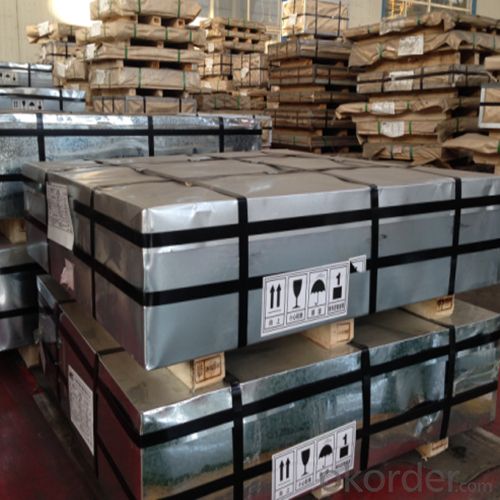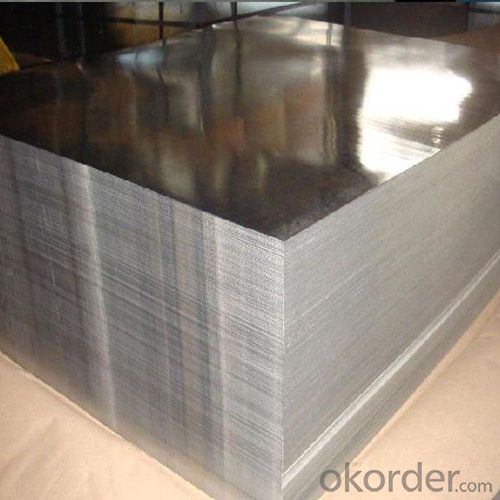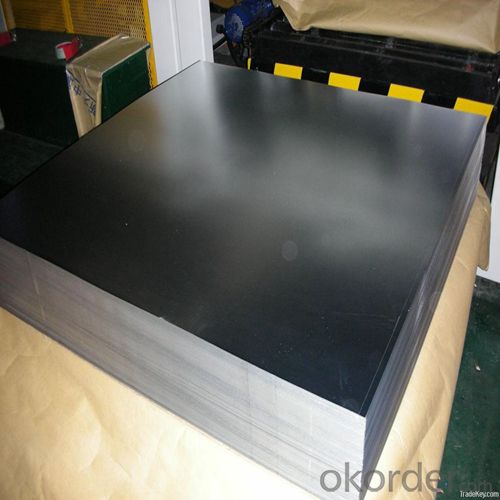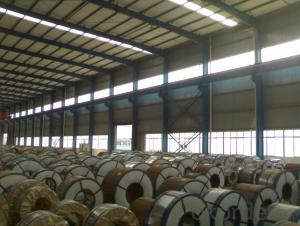Electrolytic Tinplate for Food and Chemical Packaging
- Loading Port:
- Tianjin
- Payment Terms:
- TT OR LC
- Min Order Qty:
- 25 m.t
- Supply Capability:
- 7000 m.t/month
OKorder Service Pledge
OKorder Financial Service
You Might Also Like
1.Structure of Electrolytic Tinplate for Food and Chemical Packaging Description
Electrolytic Tin Plate Coils and Sheets for Foods Metal Packaging, is one thin steel sheet with a coating of tin applied by electrolytic deposition. Tinplate made by this process is essentially a sandwich in which the central core is strip steel. This core is cleaned in a pickling solution and then fed through tanks containing electrolyte, where tin is deposited on both sides. As the strip passes between high-frequency electric induction coils, it is heated so that the tin coating melts and flows to form a lustrous coat.
2.Main Features of the Electrolytic Tinplate for Food and Chemical Packaging
Appearance – Electrolytic Tin Plate is characterized by its beautiful metallic luster. Products with various kinds of surface roughness are produced by selecting the surface finish of the substrate steel sheet.
Paintability and printability – Electrolytic Tin Plates have excellent paintability and printability. Printing is beautifully finished using various lacquers and inks.
Formability and strength – Electrolytic Tin Plates have got very good formability and strength. By selecting a proper temper grade, appropriate formability is obtained for different applications as well as the required strength after forming.
Corrosion resistance – Tinplate has got good corrosion resistance. By selecting a proper coating weight, appropriate corrosion resistance is obtained against container contents. Coated items should meet 24 hour 5 % salt spray requirement.
Solderability and weldability – Electrolytic Tin Plates can be joined both by soldering or welding. These properties of tinplate are used for making various types of cans.
Hygienic – Tin coating provides good and non toxic barrier properties to protect food products from impurities, bacteria, moisture, light and odours.
Safe – Tinplate being low weight and high strength makes food cans easy to ship and transport.
Eco friendly – Tinplate offers 100 % recyclability.
Tin is not good for low temperature applications since it changes structure and loses adhesion when exposed to temperatures below – 40 deg C.
3.Electrolytic Tinplate for Food and Chemical Packaging Images



4.Electrolytic Tinplate for Food and Chemical Packaging Specification
Standard | ISO 11949 -1995, GB/T2520-2000,JIS G3303,ASTM A623, BS EN 10202
|
Material | MR,SPCC |
Thickness | 0.15mm - 0.50mm |
Width | 600mm -1150mm |
Temper | T1-T5 |
Annealing | BA & CA |
Coil Inner Diameter | 508mm |
Weight | 6-10 tons/coil 1~1.7 tons/sheets bundle |
Passivation | 311 |
Oil | DOS |
Surface | Finish,bright,stone,matte,silver |
5.FAQ of Electrolytic Tinplate for Food and Chemical Packaging
-What your tinplate material is used for ?
Tinplate is widely used for the packaging of products. Such as food cans,
beverage cans, pet cans, closures, general line cans and so on.
Printed Tinplate is offered!!
-How to place .an order or contact you ?
Please send us Email. we will give you a quick response in seconds .
- How is your quality ?
All our quality is prime even the secondary quality . We have many years experience
In this field with serious quality control standard . Advanced equipment, We welcome your visit to our factory .
- Q:What are the common storage and handling requirements for tinplate?
- Common storage and handling requirements for tinplate include storing it in a dry and well-ventilated area, away from moisture and direct sunlight. It should be kept in a temperature-controlled environment to prevent any damage or corrosion. Proper handling techniques, such as using gloves and avoiding sharp objects, should be followed to prevent any surface scratches or dents. Tinplate should also be stacked and stored in a way that prevents any deformation or structural damage.
- Q:What are the advantages of using tinplate for electrical enclosures?
- There are several advantages of using tinplate for electrical enclosures. Firstly, tinplate offers excellent corrosion resistance, ensuring the durability and longevity of the enclosure even in harsh environments. Secondly, tinplate has high strength and rigidity, providing robust protection for the electrical components inside. Additionally, tinplate is a cost-effective option compared to other materials, making it a popular choice for mass production. Lastly, its malleability allows for complex shapes and designs, providing flexibility in enclosure manufacturing.
- Q:How is tinplate made?
- Tinplate is made by coating thin sheets of steel with a layer of tin through a process called electroplating. The steel sheets are first cleaned and prepared, then immersed in an electrolyte bath containing tin salts. When an electric current is passed through the bath, tin ions are attracted to the steel, forming a thin layer of tin on the surface. This tin coating enhances the steel's resistance to corrosion and provides a shiny and attractive finish.
- Q:How does tinplate packaging contribute to product protection against breakage?
- Tinplate packaging contributes to product protection against breakage by providing a strong and durable barrier that can withstand external pressure and impact. The rigid nature of tinplate makes it resistant to deformation and ensures that the packaged product remains intact and secure during transportation and handling. Additionally, tinplate packaging offers excellent resistance to moisture, corrosion, and temperature changes, further safeguarding the product from damage.
- Q:How does tinplate compare to stainless steel in terms of properties and applications?
- Tinplate and stainless steel have different properties and applications. Tinplate is a steel coated with a thin layer of tin, providing corrosion resistance and a shiny appearance. It is commonly used for packaging food and beverages, as it is lightweight and easily formed into cans. On the other hand, stainless steel is an alloy with high corrosion resistance and strength. It is widely used in various industries, including construction, automotive, and kitchen appliances, due to its durability and aesthetic appeal. While both materials offer corrosion resistance, stainless steel is generally stronger and more versatile, making it suitable for a wider range of applications compared to tinplate.
- Q:How is tinplate coated for paint cans?
- Tinplate is coated for paint cans through a process called electrolytic tin coating, where a thin layer of tin is applied to the surface of the steel sheet. This coating provides protection against corrosion and ensures the paint cans are suitable for storing various types of paints and coatings.
- Q:What are the key factors to consider when choosing tinplate for packaging?
- When choosing tinplate for packaging, there are several key factors to consider. These include the quality and durability of the tinplate, its corrosion resistance properties, its compatibility with the packaged product, the desired aesthetic appeal, the cost-effectiveness, and the environmental sustainability of the material. Additionally, factors like the ease of printing, forming, and sealing should also be taken into account to ensure the tinplate meets the specific packaging requirements.
- Q:What are the main challenges in recycling tinplate?
- The main challenges in recycling tinplate include separating tinplate from other materials, such as paper or plastic coatings, as well as removing any remaining food or product residues. Additionally, the tin coating on tinplate can pose challenges during the recycling process, as it needs to be separated and recovered for reuse. Finally, ensuring a consistent supply of tinplate for recycling can be a challenge due to fluctuations in consumer demand and collection efforts.
- Q:How does tinplate perform in terms of corrosion resistance compared to other materials?
- Tinplate performs exceptionally well in terms of corrosion resistance compared to other materials. Its unique composition of steel coated with a thin layer of tin provides a protective barrier against moisture and oxidation, preventing rust and corrosion. This makes tinplate highly suitable for various applications, especially in the packaging industry, where it ensures the preservation and longevity of products.
- Q:How does tinplate perform in terms of resistance to chemical agents?
- Tinplate is known for its excellent resistance to chemical agents. It has a protective tin coating that provides a barrier against corrosive substances and prevents them from interacting with the underlying metal. This resistance makes tinplate suitable for packaging various products, including food and beverages, as it helps maintain the integrity and safety of the contents.
1. Manufacturer Overview |
|
|---|---|
| Location | |
| Year Established | |
| Annual Output Value | |
| Main Markets | |
| Company Certifications | |
2. Manufacturer Certificates |
|
|---|---|
| a) Certification Name | |
| Range | |
| Reference | |
| Validity Period | |
3. Manufacturer Capability |
|
|---|---|
| a)Trade Capacity | |
| Nearest Port | |
| Export Percentage | |
| No.of Employees in Trade Department | |
| Language Spoken: | |
| b)Factory Information | |
| Factory Size: | |
| No. of Production Lines | |
| Contract Manufacturing | |
| Product Price Range | |
Send your message to us
Electrolytic Tinplate for Food and Chemical Packaging
- Loading Port:
- Tianjin
- Payment Terms:
- TT OR LC
- Min Order Qty:
- 25 m.t
- Supply Capability:
- 7000 m.t/month
OKorder Service Pledge
OKorder Financial Service
Similar products
New products
Hot products
Related keywords



























